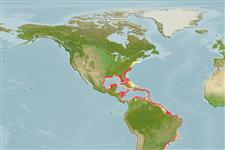>
Tetraodontiformes (Puffers and filefishes) >
Tetraodontidae (Puffers) > Tetraodontinae
Etymology: Sphoeroides: Greek, sphaira = ball + Greek, suffix, oides = similar to (Ref. 45335).
More on author: Bloch.
Environment: milieu / climate zone / depth range / distribution range
Ökologie
seewasser; brackwasser riff-verbunden; tiefenbereich 2 - 70 m (Ref. 26999). Subtropical; 43°N - 30°S, 98°W - 34°W
Western Atlantic: Massachusetts, USA to Santa Catarina, Brazil (Ref. 57756). Replaced by Sphoeroides marmoratus in the eastern Atlantic (P. Wirtz, pers. comm. 10/04).
Size / Gewicht / Alter
Maturity: Lm ? range ? - ? cm
Max length : 30.0 cm TL Männchen/unbestimmt; (Ref. 26999); common length : 12.0 cm TL Männchen/unbestimmt; (Ref. 3821)
Rückenflossenweichstrahlen (insgesamt): 9. 11-14 sharply defined round black spots on head and lower side of body. The numerous tan lappers on the rear part of the body and distinct spots along the lower side make it unmistakable (Ref. 26938).
Abundant in all inshore habitats where there is adequate cover, such as seagrass beds and reef flats. Feeds on mollusks, crustaceans and echinoderms (Ref. 36453). Generally common (Ref. 9710). Traded as an aquarium fish at Ceará, Brazil (Ref. 49392).
Life cycle and mating behavior
Geschlechtsreife | Fortpflanzung | Ablaichen | Eier | Fecundity | Larven
Robins, C.R. and G.C. Ray, 1986. A field guide to Atlantic coast fishes of North America. Houghton Mifflin Company, Boston, U.S.A. 354 p. (Ref. 7251)
IUCN Rote Liste Status (Ref. 130435)
Bedrohung für Menschen
Poisonous to eat (Ref. 3821)
Nutzung durch Menschen
Fischereien: nicht kommerziell; Aquarium: Kommerziell
Mehr Information
ReferenzenAquakulturAquakultur ProfilZuchtlinienGenetikElectrophoresesVererbbarkeitKrankheitenVerarbeitungNutrientsMass conversion
PartnerBilderStamps, Coins Misc.LauteCiguateraGeschwindigkeitSchwimmstilKiemenoberflächeOtolithsGehirngrößeSehfähigkeit
Tools
Zusatzinformationen
Download XML
Internet Quellen
Estimates based on models
Preferred temperature (Ref.
123201): 22.5 - 28, mean 25 °C (based on 472 cells).
Phylogenetic diversity index (Ref.
82804): PD
50 = 0.5000 [Uniqueness, from 0.5 = low to 2.0 = high].
Bayesian length-weight: a=0.01738 (0.01350 - 0.02236), b=2.90 (2.83 - 2.97), in cm total length, based on LWR estimates for this species (Ref.
93245).
Trophic level (Ref.
69278): 3.3 ±0.2 se; based on diet studies.
Widerstandsfähigkeit (Ref.
120179): hoch, Verdopplung der Population dauert weniger als 15 Monate. (Preliminary K or Fecundity.).
Fishing Vulnerability (Ref.
59153): Low vulnerability (20 of 100).
Nutrients (Ref.
124155): Calcium = 32.6 [10.8, 107.5] mg/100g; Iron = 0.68 [0.34, 1.43] mg/100g; Protein = 19.7 [17.5, 21.9] %; Omega3 = 0.262 [0.123, 0.509] g/100g; Selenium = 15.9 [7.1, 34.3] μg/100g; VitaminA = 42.4 [13.0, 139.6] μg/100g; Zinc = 0.993 [0.654, 1.519] mg/100g (wet weight);
